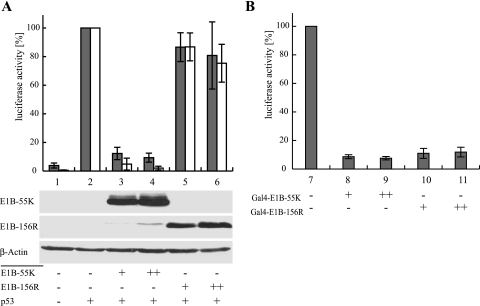FIG. 7.
E1B-156R does not repress p53-mediated transactivation but possesses a functional repression domain. In both reporter assays “+” indicates the use of a given plasmid in the corresponding lane and “++” marks the use of the higher of two possible plasmid concentrations. The means and standard deviations for four independent experiments are presented. (A) E1B-156R does not repress p53-mediated transactivation. H1299 cells were transfected with 1 μg of a construct expressing firefly luciferase under the control of a p53-dependent promoter. Two different reporter plasmids were tested in these experiments: pHH0.34-TK Luc, containing sequences of the cellular cyclin G promoter (gray bars), and pRE-Luc, with an artificial promoter containing five copies of a p53 DNA-binding motif (white bars). Each subset of experiments further contained plasmids expressing p53 (0.025 μg pC53-SN3), E1B-55K (1 or 2 μg pE1B-55K), and E1B-156R (1 or 2 μg pE1B-156R #1326). The steady-state levels of the E1B proteins were monitored by immunoblotting of lysates used in a luciferase assay. A Western blot assay of β-actin was included as a loading control. (B) E1B-156R contains a functional repression domain. H1299 cells were transfected with 1 μg of a construct expressing firefly luciferase under the control of an artificial promoter containing five Gal4 binding sites (pGalTK-Luc). The constitutive expression of this construct was repressed by addition of the Gal4 DNA-binding domain E1B fusion proteins Gal4-E1B-55K (1 or 2 μg pGal4 E1B-55kDa) or Gal4-E1B-156R (1 or 2 μg pGal4 E1B-156R #1375).

